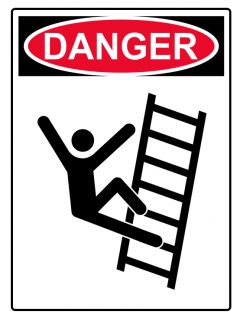Ladder Safety 101

Ladders are one of the most dangerous pieces of equipment in your facility. They account for almost 20% of fall injuries in the workplace, according to the CDC. OSHA has developed strict guidelines and regulations to help minimize the risk associated with the use of ladders. Ladder Safety 101 will help you and your team become better aware of safety when using, moving, carrying, and storing a ladder.
Always Use Common Sense
The following points will sound like common sense, however to ensure that your team does not overlook these details it’s a good idea to reinforce them on a regular basis.
- OSHA rule 1926.1053(b)(13) states that the top of a ladder should never be used as a step.
- OSHA rule 1926.1053(b)(4) states that ladders should only be used for the job in which they were designed. Ladders have various functions and your team must know the difference.
- OSHA rule 1926.1053(b)(16-17) states that ladders with any structural defects must be properly repaired or removed from service completely. The defective ladder must be clearly marked as such to discourage workers from using it until it is repaired or removed from service.
Ladders Do Have Restrictions
Risk of a fall or other related accidents are all too common when failing to comply with the following points. Knowing the weight capacity and the specific function of a ladder will allow your team to protect themselves and work safely.
- DO NOT exceed the maximum load capacity of a ladder. (load capacity information should be indicated on every ladder.)
- Only use ladders on a flat, stable surface; except when securing them to prevent displacement.
- Never shift or move a ladder while it is load bearing.
Workers Have Their Limits Too
Each worker on your team have their individual skill-sets and limitations that must be taken into consideration on the job site. You may have people who are not very comfortable on a ladder, while others may be overly confident and engage in riskier behavior. Both should heed the guidelines set by OSHA to ensure their safety on the job.
- Always face the ladder while descending and keep at least one hand on the ladder at all times.
- Refrain from carrying items up or down the ladder (seek help to have items handed up to you).
- ALWAYS consider the load capacity of the ladder before use. Overweight employees may be at higher risk for an accident if they are unable to safely maneuver on the ladder.
Maintenance is Key
Routine inspection of your ladders is mandatory under OSHA rule. You must ensure ladders remain free from grease, oil, and other slip hazards. Identify defects with regular visual inspections; all issues must be reported immediately and the ladder removed from service.
- 1926.1053(b)(18) states that any repairs made to a ladder must restore the ladder to its original condition before it is used again.
Pay Attention to Angles and Measurements
This piece of ladder safety is a bit more technical as continuous updates are made to the rules. It’s likely that you will need to consult OSHA regulations, instead of going off of memory, just to make sure you’re safe. 1926.1053(a)(3)(i-iii) provides all the specifics according to ladder type. 1926.1053(b)(5)(i-iii) provides specifics regarding safe operating angles of a ladder.
Ladder accidents can be prevented. Preparation and training on the proper use of equipment can enable your team to mitigate risk and foster a safer workplace. Check out our Safety Talks installment on Ladder Safety.
